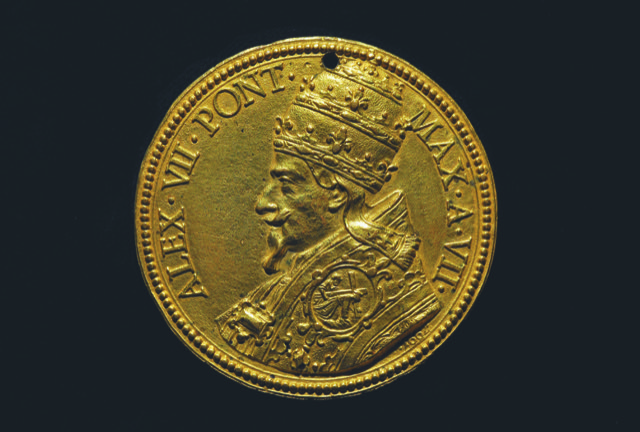

Gian Lorenzo Bernini and Gioacchino Francesco Travani, Medal with the Collegiate Church of the Assumption in Ariccia, 1662, Gilded bronze, Palazzo Chigi, Ariccia.
NOTE: William King Museum of Art in Abingdon, Virginia, hosts“Bernini and the Roman Baroque: Masterpieces from Palazzo Chigi in Ariccia,”an exhibitionwhich comprehensively maps the rich spectrum of genres and pictorial styles thatcharacterize Baroqueaesthetics and illuminates the influence ofGian Lorenzo Bernini across the Baroque movement.
“Bernini and the RomanBaroque” is on view atWilliam King Museum of Art from Oct. 14through Jan. 16.
Gian Lorenzo Bernini transformed Rome with his sculpture and architecture, making powerful works created to give the eternal city new emotionally charged art, designed to deliver deeply spiritual ideas. He was a virtuoso in many different mediums – marble, bronze, oil paint, just to name a few and able to dramatically recreate convincing flesh, hair, tree limbs, animals, human bodies – all used to revitalize Catholic Christianity in a time when the Roman Church was responding to the Protestant Reformation that began earlier in the 16th century.
Bernini ingeniously crafted drama. The rigid materials of metal and marble became capable of incredible visual movement. He employed multiple colors of marble in his complex designs. All of the space surrounding his work, including the space occupied by viewers, became a theater resulting in timeless experiences.
In addition to themes of Christianity, Bernini drew inspiration from the traditions of Judaism and ancient classical mythologies. On one hand, he is famous for the majestic bronze canopy (Baldacchino) with twisted Solomon-like serpentine columns that extend more than six-building stories in height over apostle Peter’s burial site inside St. Peters Basilica. On the other hand, Bernini reached back into classical times with mythological works such as Apollo and Daphne, one of the greatest expressions of metamorphosis ever created.
In my many travels to Rome, Bernini continually reveals his genius to me in so many ways. Yet, I am always personally transfixed by the previously mentioned Apollo & Daphne sculpture, which resides in the opulent Borghese Gallery on the outskirts of the city. The marble masterpiece includes two figures animated in space: Apollo, the young god of the sun and, Daphne, the nymph daughter of a river god. In a modern sense, Bernini’s sculpture is a classic chase scene. Most recent TV action shows include at least one chase scene, and Bernini was well ahead of his time even though he did not have modern film in his arsenal of creativity. At the end of the chase, Apollo puts his left hand on the torso of the goddess, she begins her transformation into a tree as her hands turn into leaves, and his lust for her is denied. Bernini’s sculpture of human passion is symbolic of those cherished things that we as human beings desire in life, only to find out that just when we are on the cusp of achieving those desires, they turn out differently from our expectations.
Bernini was an ambitious artist, seeking out the largest possible commissions he could receive from the Papacy. Pope Urban VIII of the powerful Barberini family hired Bernini to design and build the canopy in St. Peters. In return, Bernini honored the Pope’s family by including Barberini family shields and the family symbol, bees, into his impressive design. Bernini designed The Fountain of Four Rivers under Pope Innocent X, a project designed to get Rome thinking a bit more globally. Not only does this fountain dramatically represent the greatest rivers of the world, but it also activates the surrounding Piazza Navona with the auditory treat of splashing water.
Bernini was also a favorite of Pope Alexander VII from the wealthy Chigi family. To start, Alexander VII worked with Bernini to create the famous architectural arms of St. Peter’s Basilica now referred to as the colonnade. Bernini’s design rejected the Renaissance classical obsession with pure geometric shapes and created a space, that when seen from an aerial viewpoint, is shaped like a keyhole. After all, according to the New Testament Book of Matthew, Christ handed Peter the keys to the church. Furthermore, Bernini’s unique colonnade defines a space that is huge but also welcoming. Pope Alexander VII had the money and Bernini had the vision to carry out the projects including Alexander’s own posh and elaborate tomb in St. Peter’s Basilica featuring a skeleton’s hand holding an hourglass reminding all of us for eternity that life is short and we better make the most of it; Bernini did exactly that.
We now look back on this time in art history as the Baroque Period. The artists used strong powerful contrasts, dynamic diagonals, and an emotional approach to persuade Christians in the power of God. Many now-famous artists who created within the style, including Rembrandt, Velasquez and Rubens, spread Baroque art throughout Europe. Catholic church tradition historically supported a strong intellectual foundation for understanding God but artists working in the Baroque art period helped to change the way people felt spiritually about God.
Charles W. Goolsby is professor of art at Emory & Henry College where he chairs the Division of Visual & Performing Arts and leads the Italian Art Study Abroad program within the college’s Art Department. Professor Goolsby serves on the Board of Trustees of William King Museum of Art.